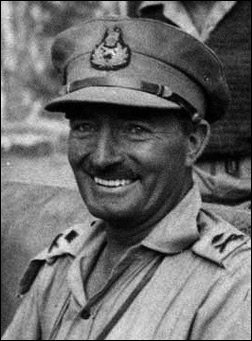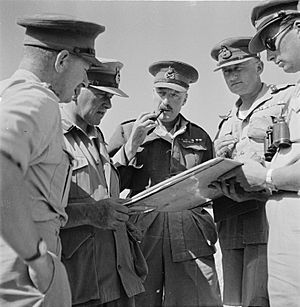George Erskine facts for kids
Quick facts for kids
Sir George Erskine
|
|
|---|---|
 |
|
| Nickname(s) | "Bobby" |
| Born | 23 August 1899 Hascombe, Surrey, England |
| Died | 29 August 1965 (aged 66) Rusper, West Sussex, England |
| Buried |
Saint Mary Magdalene Churchyard, Rusper, Horsham District, West Sussex, England
|
| Allegiance | |
| Service/ |
|
| Years of service | 1918−1958 |
| Rank | General |
| Service number | 15806 |
| Unit | King's Royal Rifle Corps |
| Commands held | 2nd Battalion, King's Royal Rifle Corps 69th Infantry Brigade 7th Armoured Division 43rd (Wessex) Infantry Division Commander of British Forces in Hong Kong British Troops in Egypt Eastern Command East Africa Command Southern Command |
| Battles/wars | World War I World War II Mau Mau Uprising |
| Awards | Knight Grand Cross of the Order of the Bath Knight Commander of the Order of the British Empire Distinguished Service Order Mentioned in despatches |
General Sir George Watkin Eben James Erskine (23 August 1899 – 29 August 1965) was an important British Army officer. He was born in Hascombe, Surrey, England. After finishing his studies at the Royal Military College, Sandhurst, Erskine joined the King's Royal Rifle Corps. He fought in World War I on the Western Front. During World War II, he led the 7th Armoured Division from 1943 to 1944. After World War II, Sir George Erskine was in charge of operations against the Kenya Land and Freedom Army during the Mau Mau Uprising in Kenya.
Contents
Early Life and First World War
George Erskine was the son of a high-ranking army officer, Major-General George Elphinstone Erskine. He went to Charterhouse School and then to the Royal Military College, Sandhurst. In 1918, he became a second lieutenant in the King's Royal Rifle Corps.
He served in World War I in France and Belgium. After the war, he continued his military education at the Staff College, Camberley from 1929 to 1930. In the 1930s, he worked in India. He returned to Britain in 1937 to take on a role at Eastern Command.
Second World War Service

In 1939, George Erskine became a staff officer for the 56th (London) Infantry Division. In 1941, he became the leader of the 2nd Battalion, King's Royal Rifle Corps. His unit was sent to North Africa. There, he received the Distinguished Service Order (DSO) in 1942 for his bravery.
He then became a Brigadier General Staff for XIII Corps. In January 1943, he was promoted to major-general. He was put in charge of the 7th Armoured Division. He led this division in North Africa, Italy, and during the Normandy landings between 1943 and 1944.
During the Battle of Normandy in 1944, the British commander, Miles Dempsey, felt that the 7th Armoured Division was not performing as well as expected. During Operation Goodwood and Operation Bluecoat, the division struggled to reach its goals. Because of this, Erskine was replaced as commander. However, this was only a temporary setback for his career. He later became the Head of the Supreme Headquarters Allied Expeditionary Force Mission to Belgium in 1944. In 1945, he became the General Officer Commanding (GOC) of the 43rd (Wessex) Infantry Division.
Later Military Career
After World War II, Erskine held several important positions. In 1946, he was the Commander British Forces in Hong Kong. From 1948 to 1949, he was the Director General of the Territorial Army. In 1949, he became the GOC British Troops in Egypt.
In 1952, he returned to the United Kingdom as GOC-in-Chief, Eastern Command. In 1953, he was appointed GOC-in-Chief, East Africa Command. In this role, he was in charge of all security forces, including the police, in Kenya. He was responsible for leading the response to the Mau Mau Uprising. He led Operation Anvil in Nairobi in April 1954.
When he took command, Erskine made it clear that he would not allow unfair treatment of anyone. He ordered officers to stop any conduct they would be ashamed of. He also took steps to investigate and prosecute officers who were responsible for serious incidents. Erskine also used strategies like moving people and holding large groups in camps to help control the situation. From 1955 to 1958, he was GOC-in-Chief, Southern Command, before he retired.
After Retirement
After retiring from the army, Sir George Erskine continued to serve. He was an Aide-de-Camp General to Queen Elizabeth II from 1955 to 1965.
He received several high honors for his service. He was made a Knight Commander of the Order of the British Empire (KBE) in 1950. He became a Knight Commander of the Order of the Bath (KCB) in 1952, and a Knight Grand Cross of the Order of the Bath (GCB) in 1955. From 1958 to 1963, he served as the Lieutenant Governor and Commander-in-Chief of Jersey.
Family Life
In 1930, George Erskine married Ruby de la Rue. They had two sons and one daughter.


